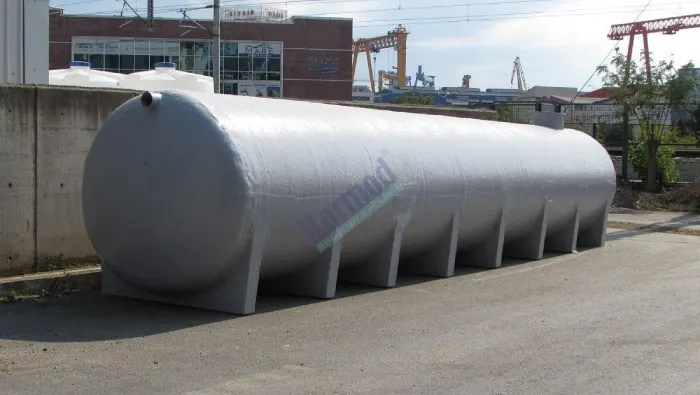
These tanks have found utility both within our country and in many countries abroad. In industries, whether the content is in liquid or solid form, they are used for the storage and preservation of produced contents, as well as for transportation purposes.
Furthermore, in our homes, they serve various purposes. Looking at the general utility of these water tank models, they are vehicles that allow the storage of chemicals or food content, protection from external environmental conditions, transportation if needed, and discharge for usage when required.
Moreover, in villages or areas with a dense rural population, the usage of these tanks is highly prevalent. Ranging from rainwater storage systems to various specific purposes, they are extensively used. For these special purposes, consider storing milk, grains, agricultural chemicals, and for irrigation.
Why Are Septic Tanks Used?
Septic waste is present in many regions, including urban areas. However, in urban areas, sewage is diverted away from the region through sewage infrastructure. In some cases, due to the inability of local administrations to provide sewage infrastructure in rural areas, this waste sometimes seeps into gardens and fields.
From this perspective, septic tanks can be used wherever sewage infrastructure is absent. Generally, tanks are used to protect the content; however, septic tanks not only safeguard the contents but also shield the surrounding environment from the content inside. This is because septic waste carries a strong and unpleasant odor. Hence, septic tanks are carefully buried underground.
How Are Septic Tanks Buried Underground?
The above-ground use of these tanks is highly unlikely. This is because septic waste is not something people want to be exposed to. However, there are instances where septic tanks used for animal manure are kept above ground. In such cases, they are usually painted in a color that conceals their contents. The method of burying these tanks underground is a topic of great curiosity. Let's clarify this process.
Septic tanks can be divided into two types based on the raw materials: polyethylene and polyester. For storing septic waste, we recommend polyester tanks, although polyethylene tanks can also be used if preferred. Polyethylene tanks can also be buried underground, but they are mostly used for purposes like storing rainwater. Additionally, the installation of the tank should be done while it's empty. During the installation of inlet and outlet pipes, care should be taken not to over tighten the manholes on the tank.
The Phases of Burying Underground Tanks are as Follows:
The area where the tank will be buried is excavated slightly larger than the tank dimensions with the help of an excavator.
Concrete is poured onto the floor of the excavated pit, reinforced with iron rods that are 25 centimeters thick. If the tank stands on a platform, ensure that the platform is not porous.
Carefully lower the tank into the pit with the help of a crane. Adjust it to a level position.
Walls with a gap of 10 centimeters between the tank surface and the pit, made of materials like bricks, are built around the edges of the pit. If walls are not desired, fine sand is poured around the tank, leaving the cap and neck exposed.
It is advised not to have vehicular traffic over the tank.
Upon completing these steps, your septic tank can be used for many years. To increase capacity, connections can be established between multiple tanks. This way, you can accommodate future needs for increased capacity.
General Characteristics of Water Tanks
These tanks offer numerous advantages to users, both in terms of their design and overall structure. Tanks are produced using three distinct raw materials: polyethylene, polyester, and stainless steel. These materials are meticulously chosen as they do not interfere with the structure of the content, thanks to extensive R&D studies.
The tanks have their advantages predominantly in terms of raw material and design. In polyester tanks and stainless-steel depots, large tonnage tanks can be manufactured. Polyethylene tanks, on the other hand, are highly suitable for food storage and can produce tanks in very small sizes. The advantages of tanks are too numerous to list. However, they also share common features.
Here are the common features of tanks:
- They offer on-site assembly advantages.
- Tanks with very large tonnages can be produced.
- Size range is between 50 liters and 100,000 liters.
- Since they can be produced in any desired color, the stored content can be easily categorized.
- Special project options are available.
- They have high UV stabilization.
- Operating temperature ranges from -5 to +80 degrees Celsius.
- Damaged tanks due to usage can be repaired at our facilities.
- All tanks have a two-year warranty.
- They are stainless and corrosion resistant.
- As the size increases, some models have ladder support added to their design.
- Cleaning and maintenance are quite easy.
- All tanks are manufactured using state-of-the-art production systems.
- Poor-quality raw materials are not used during tank production.
- They are long-lasting and durable.
- They are produced in compliance with environmental and health management systems.


 EN
EN
 DE
DE
 FR
FR
 IT
IT
 ES
ES
 PT
PT
 RU
RU
 AR
AR
 BG
BG
 SR
SR
 GR
GR
 SQ
SQ
 RO
RO
 PL
PL
 HU
HU
 CZ
CZ
 HR
HR
 AZ
AZ
 GE
GE
 AM
AM
 IL
IL